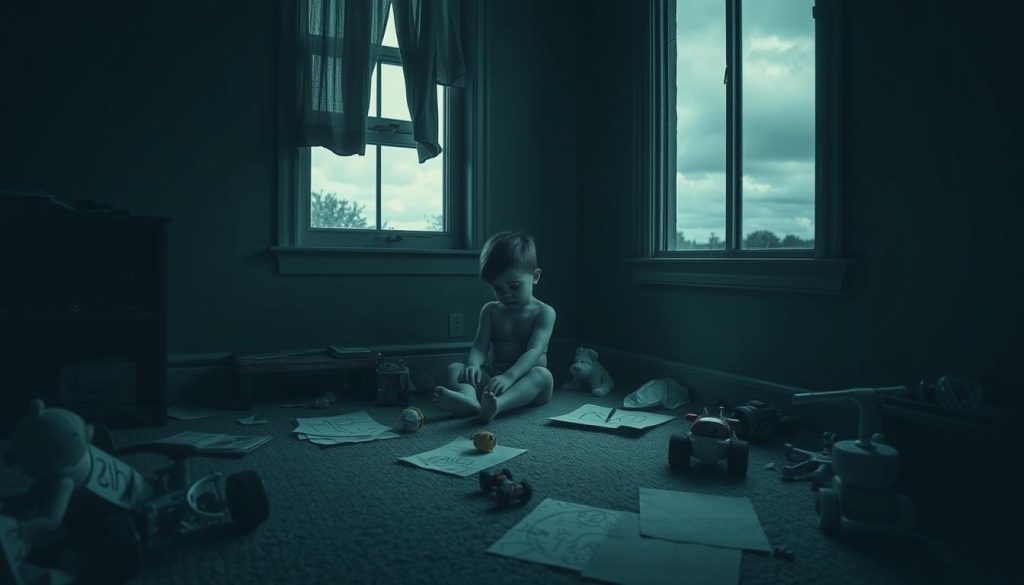How do you talk to your child about self-harm without scaring them off? It’s a tough conversation for parents. Self-harm is a sensitive topic, especially when it’s about your child. This section gives you tips and strategies to have this talk with care and understanding.
Starting this conversation needs a mix of firmness and kindness, known as gentle parenting. Many parents worry about saying something wrong or pushing their kids away. Using kind words and showing support is key. It’s important to pick the right time and place for this talk, so your child feels safe and listened to.
Talking about self-harm is more than just the act itself. It’s about the feelings and thoughts behind it. A honest and caring conversation can help your child feel less alone and more ready to get help. Building strong family communication can help your child heal.
Key Takeaways:
- Approach the conversation about self-harm with empathy and sensitivity, using gentle parenting techniques.
- Choose an appropriate time and setting to ensure your child feels safe and open to discussion.
- Understand that talking to kids about difficult topics requires non-judgmental and supportive communication.
- Recognize the emotional and psychological factors behind self-harm behaviors.
- Implement effective family communication strategies to foster a supportive environment.
- Be informed about the signs and indicators of self-harm to identify and address the issue promptly.
Understanding Self-Harm
Self-harm, or non-suicidal self-injury (NSSI), is when someone hurts themselves on purpose but doesn’t want to die. It includes actions like cutting, burning, and bruising. These behaviors are common among teens but are often not understood well.
Many think only certain genders or people who want attention do this. But it’s more complex than that. It’s a way some people deal with their feelings.

Defining Self-Harm and Its Forms
Self-harm is when someone hurts themselves on purpose to feel better emotionally. It can be cutting, burning, or scratching. Studies show about 10-15% of young people in the UK and Ireland have done this.
It’s important to know about these behaviors to help people properly.
Common Misconceptions About Self-Harm
There are many wrong ideas about self-injury, especially in teens. Some think it’s just for attention, but it’s really a way to handle strong feelings. People also think only girls do this, but boys do too, even if girls do it more.
Knowing these myths helps us spot self-harm and support kids’ mental health better.
Indicators and Signs of Self-Harm in Children
Finding out if a child is self-harming can be hard. Look for things like unexplained injuries, bruises, and scars. They might also act sad or change moods a lot.
Parents and caregivers need to watch for these signs. This way, they can help early and support their kids better.
Initiating the Conversation with Compassion
Talking to your child about self-harm can feel scary. But, with gentle parenting and a safe space, you can start a real conversation. It’s important to be kind, understanding, and patient.
Choosing the Right Time and Setting
Finding the right time and place to talk is key. Make sure the setting is calm and free from distractions. A quiet, private spot where your child feels safe is best.
Using Empathetic Language
Listening with empathy is crucial. Speak in a way that shows you care and get it without judging. Saying “I’m here for you” or “I understand this is tough” helps a lot. Your goal is to make your child feel heard and valued.
Encouraging Open Dialogue
Open conversation is important. Let your child share their feelings and stories without being cut off. Ask questions that encourage them to talk more and listen well. Studies show that being non-judgmental can strengthen your bond and help your child feel more emotionally strong.
Exploring Underlying Causes
Understanding why children harm themselves is key. We must look at depression, anxiety, ADHD, and family stress. Knowing these factors helps us find the right help and support.
Emotional and Psychological Factors
Emotional pain and mental health issues often lead to self-harm. Conditions like depression, anxiety, and ADHD make kids feel hopeless. Teenage struggles, like figuring out who they are, also play a big role. By recognizing these, we can better support our children’s mental health.

Influence of Social Media and Peer Relationships
Social media and friends have a big impact. Cyberbullying and the pressure to fit in online can make kids feel alone and not good enough. Seeing perfect lives on social media can be hard for teens. Knowing this helps us guide our kids through the digital world.
Family Dynamics and Mental Health
Family life affects a child’s mind. Stress, money worries, and balancing family needs are common. Many parents find parenting tough, with 62% saying it’s harder than expected.
Understanding these challenges is crucial. A loving home can help prevent self-harm and support mental health.
Parenting Challenges: Supporting Your Child Through Difficult Times
Parenting can be tough, especially when dealing with stepchild relationships, divorce, middle child syndrome, and remarriage. These situations can lead to self-harm in children.

Children may act out and get rejected by peers, affecting everyone. Criticizing them doesn’t help. Instead, showing empathy and understanding is key. This makes them feel heard and helps them think about their actions.
Building trust is crucial in stepchild and remarriage situations. Give them a safe space to reflect without judgment. This lets them make their own choices and feel empowered. Working together to understand social situations can also help change behavior.
Always ask permission before giving advice and offer tools like cue words. This is vital for managing sibling rivalry and middle child syndrome. Being honest about family changes due to divorce is also important, but do it in a way that’s safe for kids.
Children with too much anxiety might seem irritable or withdrawn. They might even have physical symptoms like stomach issues. Parents and teachers should keep routines consistent to offer comfort and stability. Reducing screen time and watching social media use can also help their mental health.
In tough times, being empathetic and understanding is crucial. It helps children feel supported and able to handle their emotions and actions. This support is essential for dealing with the challenges of stepchild relationships, remarriage, and other complex family situations.
Seeking Professional Help and Resources
When dealing with self-harm in kids, getting professional help is key. It helps both the child and the family get the right care. This is crucial for managing this tough situation.
Consulting Your Pediatrician and Mental Health Professionals
First, consulting pediatricians is a good start. They can create a care plan for your child. They might suggest therapy or medication based on your child’s needs.
You might also be referred to child psychologists or psychiatrists. They specialize in helping young people with mental health issues.

Engaging with School Resources
Schools play a big role in supporting kids through counseling services. School counseling programs offer professional help in school. This helps with both emotional and academic growth.
Schools also host workshops and provide mental health resources. These are great for building a supportive network for kids.
Online and Community Support Networks
Online family therapy is another option for ongoing support. Many online platforms offer programs for self-harm and mental health issues. This makes it easy to get help when you need it.
Joining local community support for families adds more support. It’s a place to share experiences and find strength in others facing similar challenges.
By using these mental health resources, you can create a strong support plan for your child. This includes working with pediatricians, school counselors, and online and community groups. Together, you can help your child through tough times.
Conclusion
Dealing with self-harm in families needs care, understanding, and action. Building strong family support helps kids feel safe and heard. Studies show that good parenting, like quality teaching and being responsive, boosts kids’ minds and feelings.
Finding the reasons behind self-harm is key. It involves looking at emotional stress, mental health, and social media’s impact. Family involvement is crucial, with dads playing a big role in shaping kids’ behavior and feelings. Research shows that dads’ involvement in parenting helps kids a lot.
A full approach is needed, including professional help, school support, and community networks. The U.S. Health and Human Services and Education departments stress the role of family in kids’ early growth. By talking openly and being part of your child’s healing, you help their mental health and create a supportive space.
FAQ
How should I approach the sensitive topic of self-harm with my kids?
What is self-harm and what forms can it take?
What are the common misconceptions about self-harm?
What indicators and signs should I look for in children who might be self-harming?
How can I choose the right time and setting to talk about self-harm with my child?
What kind of empathetic language should I use?
How should I encourage open dialogue with my child about self-harm?
What are some of the emotional and psychological factors that can contribute to self-harm?
How can social media and peer relationships influence self-harming behavior?
What role do family dynamics play in a child’s mental health?
How do I support my child through the unique challenges they face, such as divorce or being a middle child?
When should I consider seeking professional help for my child who is self-harming?
How can schools assist in addressing self-harm among students?
What online and community support networks are available for families dealing with self-harm?
This post contains affiliate links. If you click on a link and make a purchase, I may earn a small commission — at no extra cost to you. Thank you for supporting this blog and helping me keep the patterns free! Read the full Affiliate Disclosure & Transparency.
